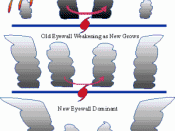This study aims to [explain] how work group sex composition influences men and women, and how demographic diversity influences organizations and their members and how sex diversity influences various work processes and outcomes(p193), following the lead of past research and rely on the similarity attraction paradigm.
The authors argue the stereotype of the minority and status expectations states theory, to distinguish their impact together with similarity attraction theory. as result, they tested four hypotheses in research[Deduction]:
Hypothesis 1 is relative to status expectations states theory, hypothesis 2a,b,c are relative to similarity attraction theory.
They studied 178 professional men and women respondents [cross-sectional design] (from [survey] covered 189, they dropped 4 unconformable and 7 incomplete[Sampling error]), in three [randomly] chosen divisions of a large clothing and manufacturer.[Stratified]
Respondent's participation in the research was voluntary and their data would be confidential.[ethical]
They conducted a field study to investigate whether men and women reacted differently to being members of homogeneous, majority male/female, minority male/female and balanced work groups.
Respondents indicated their sex on the survey.[Self-completion Questionnaires]
For dependent variables: the author used deferent methods: they asked respondents a hypothetical question under seven marks to [measure] their likelihood of transferring from current work group, used Caldwell, Chatman and O'Reilly's (1990) eight-item scale to assess normative commitment [replication], also assessed respondents positive affect and their groups cooperation using previous scales. They controlled respondents status, age, education, knowledge, work team tenure and race.
They used[Statistics]: mean , s.d, formulas etc. [Quantitative]
They found that: Hypothesis 1: was completely supported and Hypothesis 2a,b,c: were partially supported in women side. However, contrary to hypothesis 2a,b,c men who worked in homogeneous were less committed to the organization, expressed the lowest levels of positive...


